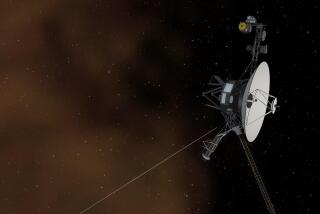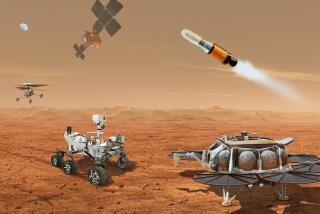NASA rover Spirit ‘revolutionized’ how we see Mars
It was supposed to roam the surface of Mars for only three months and cover a distance of just a few hundred yards. Instead, NASA’s Spirit rover traveled nearly five miles over five years, finding geological evidence that the Red Planet had once been warm and wet enough to have harbored life. Even after it got hopelessly stuck in the powdery soil of Gusev crater, the rover continued to make discoveries and beamed them to scientists millions of miles away.
But engineers at the Jet Propulsion Laboratory in La Canada Flintridge sent their final commands to Spirit early Wednesday morning, more than a year after the rover made its last transmission to Earth.
After seven years on Mars, the craft had exhausted its batteries, and its electronic innards had probably been destroyed during the long Martian winter, with temperatures sinking to about 150 degrees below zero.
“It’s very sad,” said Diana Blaney, a geologist and spectroscopist who has been examining the pictures sent by Spirit and its twin rover, Opportunity, since they arrived on Mars. “I honestly thought up until March that Spirit was going to pull through.”
Opportunity continues to soldier on on the opposite side of the planet.
Scientists at JPL mourned the loss of Spirit because they, like many people around the world, had come to think of the two explorers almost as living beings, said John Callas, project manager for the rovers. But they also celebrated its achievements.
“It’s impossible to think about Mars before the rovers — they’ve so revolutionized our understanding of this planet,” Callas said. “The Red Planet is no longer this distant alien world. It’s now a familiar place, and Spirit has given us that.”
The launch of the two rovers in 2003 came at a difficult time for planetary exploration in general and for JPL in particular. The lab’s previous two Mars missions, the Mars Climate Orbiter and the Mars Polar Lander, had both failed in 1999. The loss of the Mars Climate Orbiter, which disintegrated as it plunged into the atmosphere, was particularly embarrassing because a contractor had programmed it in English units of measurement rather than the required metric units.
Britain’s Beagle 2 lander, scheduled to land Christmas Eve 2003, disappeared without a trace during its descent. That same month, Japan aborted the mission of its Nozomi Mars orbiter because of problems with its navigation system and other equipment.
A lot of hopes were therefore riding on Spirit when it made its fiery descent through the thin Martian atmosphere on Jan. 3, 2004. When the JPL team acquired a signal from the craft at 8:51 that evening, then-NASA Administrator Sean O’Keefe proclaimed, “We’re back. This is a big night for NASA.”
Planning for the Mars Exploration Rovers had begun more than a decade earlier. JPL’s initial idea was to investigate what the planet’s geology had been like about 3.5 billion to 4 billion years ago, when life was beginning to develop on Earth. A crucial part of the proposal was to make two rovers and deploy in different places.
“The cost is not twice as much as one because a lot of the expense is in the design and validation,” Callas said. “You get twice the bang at less than twice the cost.”
The initial price tag for the twin-rover mission was $820 million.
Spirit and Opportunity were equipped with a variety of onboard instruments to study rocks on Mars.
Each rover has “eyes” — sharp color cameras that capture images for scientists to study (as well as navigation imagers that help it avoid hazards while driving from place to place). They each have a robotic arm that contains a microscopic imager that is the equivalent of a geologist’s hand lens, a rock abrasion tool to help see material just beneath the surface, and spectrometers to examine the composition of the Martian surface.
“Spirit and Opportunity are basically geological explorers,” said Ray Arvidson, a professor of Earth and planetary sciences at Washington University in St. Louis who serves as deputy principal investigator for the rovers’ scientific payload.
At 384 pounds apiece, each was more than 15 times the weight of Sojourner, the toy-like rover that had been carried to Mars’ surface by the Pathfinder mission in 1997. That required a completely new way of doing things.
Seven months into its journey, Spirit entered the Martian atmosphere at 12,000 mph. Thus began a complex descent-and-entry sequence Callas described as “six minutes of terror.”
After friction slowed its descent to less than 1,000 mph in just a few minutes, the lander deployed a parachute and reduced its speed to 200 mph. Just before the lander reached the surface, retro rockets slowed it almost to a stop. Seventeen-foot-high airbags inflated and the craft bounced to a halt in massive Gusev crater.
Within hours, Spirit unfolded its panoramic cameras and sent back the first of thousands of images of the Martian surface. On the third day of the mission, Spirit beamed back three-dimensional panoramic images of Gusev, and scientists and reporters donned tacky paper glasses — red in one eye and blue in the other — to observe the spectacular views.
The mission immediately was hit with a scientific curveball. Extensive imaging from orbit had suggested that Gusev had sedimentary rock layers, which would allow the craft to search for evidence of water early in Martian history. But when Spirit landed, researchers discovered that it was really a volcanic plain, relatively uninteresting.
It was only when the craft began making its way to the nearby Columbia Hills that it began to make crucial finds about Mars’ potential for harboring life.
With Spirit, lemons always seemed to turn into lemonade. The first of its six wheels broke in 2006, forcing rover pilots to drive the vehicle backward. By dragging the inoperable wheel, Spirit uncovered a kind of rock called amorphous silica. That provided evidence of previous hydrothermal activity, perhaps hot springs like those at Yellowstone National Park or cracks in the Martian crust called fumaroles that once released acidic steam. On Earth, both hot springs and fumaroles are teeming with organisms.
“It’s a big deal because not only do you have water, you have an energy source that could drive an ecosystem,” Callas said. “It made its biggest discovery because of a setback.”
In early 2009, as Spirit was driving toward a pair of volcanic features in the southern hemisphere named Von Braun and Goddard, its wheels broke through the thin crust and sank into powdery sand. A second wheel became immobilized, and efforts to extricate it simply dug it in deeper.
But the craft had plowed so deeply that it found ferric sulfate, calcium sulfate and silica, which could be evidence that snow or ice had been there in the fairly recent past. Scientists were surprised to find evidence of water in Mars’ past so close to the equator instead of just at the poles.
In January 2010, NASA officially gave up trying to dig Spirit out, and the explorer became an immobile scientific observatory. Researchers had hoped to use radio signals from the craft to track the planet’s wobble in orbit, which might reveal whether Mars had a liquid or a solid core. But the Martian winter was fast approaching, and the craft went into hibernation mode because there was not enough sunlight to recharge its batteries. It sent its final message on March 22, 2010.
“I am very depressed — Spirit has been my baby for seven years now,” said John Wright, a member of the rover’s driving team who began directing Spirit’s movements days after it landed on the Martian surface. “We were waiting and waiting to hear something, and never did.”
Even in death, Spirit’s scientific contributions will continue, Blaney said. Researchers will monitor the craft and its tire tracks from the Mars Reconnaissance Orbiter to learn how wind and dust remake the Martian surface.
More to Read
Sign up for Essential California
The most important California stories and recommendations in your inbox every morning.
You may occasionally receive promotional content from the Los Angeles Times.











